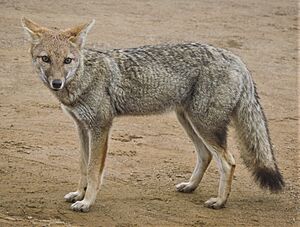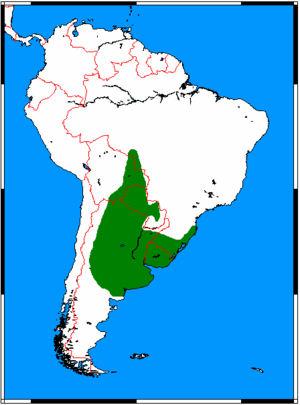Pampas fox facts for kids
Quick facts for kids Pampas fox |
|
|---|---|
 |
|
| Conservation status | |
| Scientific classification | |
| Genus: |
Lycalopex
|
| Species: |
gymnocercus
|
| Subspecies | |
|
|
 |
|
| Natural range shown in green | |
The Pampas fox (Lycalopex gymnocercus) is a medium-sized fox from South America. It lives in the Pampas grasslands. People also call it the grey pampean fox or Azara's fox. The name 'Azara' comes from a Spanish naturalist named Félix de Azara. In Guaraní, it's called aguará chaí, and in Portuguese, it's graxaim.
Contents
Pampas Fox Appearance
The Pampas fox looks a lot like the culpeo (Andean fox). But it has a wider nose and reddish fur on its head and neck. It also has a black mark on its muzzle.
Its fur is short and thick. It's mostly grey, with a black line down its back and tail. Its belly is very pale, almost white. The ears are big and shaped like triangles. They are reddish on the outside and white on the inside.
The inside of its legs are light-colored. The front legs are reddish on the outside, and the back legs are grey. The lower part of the back legs has a clear black spot. Adult Pampas foxes are about 51 to 80 cm long. They weigh between 2.4 and 8.0 kg. Males are usually about 10% heavier than females. Foxes living in the northern parts of their range have richer, brighter colors.
Where Pampas Foxes Live
The Pampas fox lives mainly in northern and central Argentina, Uruguay, eastern Bolivia, Paraguay, and southern Brazil. It likes open grassland areas called pampas. These areas are often near farms.
However, you can also find them in mountain forests or chaco forests. They live in dry scrubland and wet areas too. They are most common below 1,000 meters in height. But they can live in puna grasslands up to 3,500 meters high.
Scientists recognize five main types, or subspecies, of the Pampas fox:
- L. g. antiquus: Found in the Pampas grasslands and woodlands of central Argentina.
- L. g. domeykoanus: Found in Copiapó Province, Chile.
- L. g. gracilis: Found in the Pampas around Mendoza, Argentina.
- L. g. gymnocercus: Found in the warm grasslands of northeastern Argentina, Uruguay, Paraguay, Bolivia, and eastern Brazil.
- L. g. maullinicus: Found in Llanquihue Province, Chile, east of Llanquihue Lake.
Fossils of this fox have been found in Argentina. They date back to the late Pliocene and early Pleistocene periods.
Pampas Fox Names
In areas where people speak Spanish, the Pampas fox is known as zorro de las pampas or zorro gris pampeano. In Brazil, where people speak Portuguese, it is called graxaim or sorro.
Pampas Fox Behavior and Diet
Pampas foxes usually live alone. But during breeding season, a male and female fox will stay together. They form a pair to raise their young. These foxes are mostly nocturnal, meaning they are active at night. They start moving around at dusk. Sometimes, though, you might see them during the day.
They make their dens in any available hole. This includes caves, hollow trees, or burrows dug by other animals like viscachas or armadillos. Even when raising pups, adult foxes usually hunt by themselves. They mark their territory by leaving droppings in special spots. A typical Pampas fox's home range is about 260 hectares.
Pampas foxes eat many different kinds of food. They are more omnivorous than most other dog-like animals. Their main foods are birds, rodents, hares, fruit, and insects. They also eat dead animals. Sometimes, they eat lizards, armadillos, snails, and other small creatures. They might even eat lambs or eggs from birds that nest on the ground. Their main predators are pumas, pet dogs, and large snakes like anacondas.
Pampas Fox Reproduction
Pampas foxes breed in the early spring. The female fox can get pregnant only once each year. After being pregnant for 55 to 60 days, the mother gives birth. She can have up to eight baby foxes, called kits.
The young kits are born between September and December. They stop drinking their mother's milk when they are about two months old. Female foxes can have their own babies when they are one year old. In zoos, Pampas foxes have lived for up to 14 years.
The pups stay in their dens until they are at least 3 months old. Then, they start hunting with their parents. The male fox brings food back to the den for the female and the kits.
Threats to Pampas Foxes
The biggest danger to the Pampas fox comes from humans. People hunt them for their fur. They also hunt them to stop them from attacking farm animals. Pampas foxes can also be affected when their natural homes are destroyed.
However, the Pampas fox is still common in most areas where scientists have studied them. Because of this, the Pampas fox is not currently considered an endangered species.
Dog-Fox Hybrids
It is very rare for different types of dog-like animals to have babies together. In 2021, a strange-looking animal was found in Brazil. DNA tests showed that this animal was a mix of a Pampas fox and a domestic dog. This was the first time scientists had ever found a hybrid between these two species. People called this new animal a 'Dogxim' or 'graxorra'.



